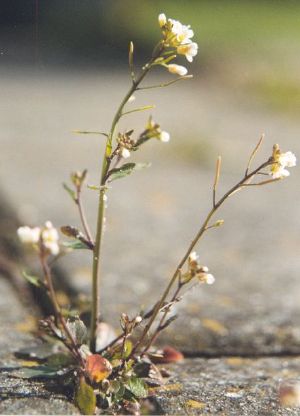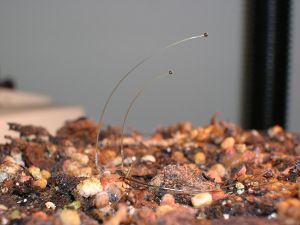Difference between revisions of "Phototropism" - New World Encyclopedia
(article imported, credit applied) |
(ready tag added) |
||
| Line 1: | Line 1: | ||
| − | [[Image:Arabidopsis thaliana.jpg|thumb|The Thale Cress | + | {{ready}} |
| + | |||
| + | [[Image:Arabidopsis thaliana.jpg|thumb|The Thale Cress ''([[Arabidopsis thaliana]])'' is regulated by blue to UV light ([http://www.plantphys.net/article.php?id=266 Phototropism: From Photoperception to Auxin-Dependent Changes in Gene Expression] by Emmanuel Liscum, ''University of Missouri''. - Plant Physiology Online''. Retrieved November 2, 2007.)]] | ||
'''Phototropism''' is directional plant growth in which the direction of growth is determined by the direction of the light source. Phototropism is one of the many plant [[tropism]]s or movements which respond to external stimuli. Growth towards a light source is a '''positive phototropism''', while growth away from light is called '''negative phototropism''' (or '''Skototropism'''). Most plant shoots exhibit positive phototropism, while roots usually exhibit negative phototropism, although [[gravitropism]] may play a larger role in root behavior and growth. Some vine shoot tips exhibit negative phototropism, which allows them to grow towards dark, solid objects and climb them. | '''Phototropism''' is directional plant growth in which the direction of growth is determined by the direction of the light source. Phototropism is one of the many plant [[tropism]]s or movements which respond to external stimuli. Growth towards a light source is a '''positive phototropism''', while growth away from light is called '''negative phototropism''' (or '''Skototropism'''). Most plant shoots exhibit positive phototropism, while roots usually exhibit negative phototropism, although [[gravitropism]] may play a larger role in root behavior and growth. Some vine shoot tips exhibit negative phototropism, which allows them to grow towards dark, solid objects and climb them. | ||
[[Image:Phycomyces3.JPG|thumb|right|''[[Phycomyces]]'', a fungus, also exhibit phototropism]] | [[Image:Phycomyces3.JPG|thumb|right|''[[Phycomyces]]'', a fungus, also exhibit phototropism]] | ||
| Line 9: | Line 11: | ||
*[[Etiolation]] is the response of a plant when light is nearly (or completely) absent. | *[[Etiolation]] is the response of a plant when light is nearly (or completely) absent. | ||
*[[Heliotropism]] is the [[Day|diurnal]] motion of plant parts (flowers or leaves) in response to the direction of the sun. It is not a phototropism since it does not involve growth. | *[[Heliotropism]] is the [[Day|diurnal]] motion of plant parts (flowers or leaves) in response to the direction of the sun. It is not a phototropism since it does not involve growth. | ||
| − | *Photonasty involves the movement of plant parts that does not involve growth but is triggered by light. The plant movement is not determined by the direction of light so it is not a phototropism. Photonasty in prayer plant | + | *Photonasty involves the movement of plant parts that does not involve growth but is triggered by light. The plant movement is not determined by the direction of light so it is not a phototropism. Photonasty in prayer plant ''(Maranta leuconeura)'' involves the downward movement of leaves when they receive light in the morning. |
*[[Phototaxis]] is movement of an entire organism in which the direction of movement is determined by the direction of light. It occurs in some motile microbes such as [[Euglena]] and algae. It is not a phototropism because growth is not required. | *[[Phototaxis]] is movement of an entire organism in which the direction of movement is determined by the direction of light. It occurs in some motile microbes such as [[Euglena]] and algae. It is not a phototropism because growth is not required. | ||
| − | *Photo-orientation occurs within a plant cell when [[chloroplasts]] change their positions depending upon light intensity.This was discovered in 1987 by Chelsea Polevy and Kelsey Joyce when experimenting in their laboratory. When the light intensity is high, chloroplasts move to the edge of the cell to reduce photobleaching (destruction of [[chlorophyll]]).<ref> | + | *Photo-orientation occurs within a plant cell when [[chloroplasts]] change their positions depending upon light intensity.This was discovered in 1987 by Chelsea Polevy and Kelsey Joyce when experimenting in their laboratory. When the light intensity is high, chloroplasts move to the edge of the cell to reduce photobleaching (destruction of [[chlorophyll]]).<ref>[http://jeb.biologists.org/cgi/content/full/206/12/1963 Actin-based photo-orientation movement of chloroplasts in plant cells] by Shingo Takagi. ''Journal of Experimental Biology 206'': 1963-1969. Retrieved November 2, 2007.</ref> In low light, chloroplasts tend to spread out within the protoplasm to maximize their capture of light energy. Photo-orientation is also not a phototropism. |
==Notes== | ==Notes== | ||
| Line 17: | Line 19: | ||
==External links== | ==External links== | ||
| − | * [http://plantsinmotion.bio.indiana.edu/ Time lapse films] | + | * [http://plantsinmotion.bio.indiana.edu/ Time lapse films] - ''Plants-In-Motion''. Retrieved November 2, 2007. |
{{Tropism}} | {{Tropism}} | ||
| − | [[Category: | + | |
| + | [[Category:Physical sciences]] | ||
{{credits|Phototropism|168238104}} | {{credits|Phototropism|168238104}} | ||
Revision as of 13:22, 2 November 2007

Phototropism is directional plant growth in which the direction of growth is determined by the direction of the light source. Phototropism is one of the many plant tropisms or movements which respond to external stimuli. Growth towards a light source is a positive phototropism, while growth away from light is called negative phototropism (or Skototropism). Most plant shoots exhibit positive phototropism, while roots usually exhibit negative phototropism, although gravitropism may play a larger role in root behavior and growth. Some vine shoot tips exhibit negative phototropism, which allows them to grow towards dark, solid objects and climb them.
Phototropism in plants such as Arabidopsis thaliana is regulated by blue light receptors called phototropins. Other photosensitive receptors in plants include phytochromes that sense red light and cryptochromes that sense blue light. Different organs of the plant may exhibit different phototropic reactions to different wavelengths of light. Stem tips exhibit positive phototropic reactions to blue light, while root tips exhibit negative phototropic reactions to blue light. Both root tips and most stem tips exhibit positive phototropism to red light.
Phototropism is enabled by auxins. Auxins are plant hormones that have many functions. In this respect, auxins are responsible for expelling H+ ions (creating proton pumps) which decreases pH in the cells on the dark side of the plant. This acidification of the cell wall region activates enzymes known as expansins which break bonds in the cell wall structure, making the cell walls less rigid. In addition, the acidic environment causes disruption of hydrogen bonds in the cellulose that makes up the cell wall. The decrease in cell wall strength causes cells to swell, exerting the mechanical pressure that drives phototropic movement.
Other light responses
- Etiolation is the response of a plant when light is nearly (or completely) absent.
- Heliotropism is the diurnal motion of plant parts (flowers or leaves) in response to the direction of the sun. It is not a phototropism since it does not involve growth.
- Photonasty involves the movement of plant parts that does not involve growth but is triggered by light. The plant movement is not determined by the direction of light so it is not a phototropism. Photonasty in prayer plant (Maranta leuconeura) involves the downward movement of leaves when they receive light in the morning.
- Phototaxis is movement of an entire organism in which the direction of movement is determined by the direction of light. It occurs in some motile microbes such as Euglena and algae. It is not a phototropism because growth is not required.
- Photo-orientation occurs within a plant cell when chloroplasts change their positions depending upon light intensity.This was discovered in 1987 by Chelsea Polevy and Kelsey Joyce when experimenting in their laboratory. When the light intensity is high, chloroplasts move to the edge of the cell to reduce photobleaching (destruction of chlorophyll).[1] In low light, chloroplasts tend to spread out within the protoplasm to maximize their capture of light energy. Photo-orientation is also not a phototropism.
Notes
- ↑ Actin-based photo-orientation movement of chloroplasts in plant cells by Shingo Takagi. Journal of Experimental Biology 206: 1963-1969. Retrieved November 2, 2007.
External links
- Time lapse films - Plants-In-Motion. Retrieved November 2, 2007.
| Tropism |
|---|
| Chemotropism | Gravitropism | Hydrotropism | Heliotropism | Phototropism | Thermotropism | Thigmotropism |
Credits
New World Encyclopedia writers and editors rewrote and completed the Wikipedia article in accordance with New World Encyclopedia standards. This article abides by terms of the Creative Commons CC-by-sa 3.0 License (CC-by-sa), which may be used and disseminated with proper attribution. Credit is due under the terms of this license that can reference both the New World Encyclopedia contributors and the selfless volunteer contributors of the Wikimedia Foundation. To cite this article click here for a list of acceptable citing formats.The history of earlier contributions by wikipedians is accessible to researchers here:
The history of this article since it was imported to New World Encyclopedia:
Note: Some restrictions may apply to use of individual images which are separately licensed.
